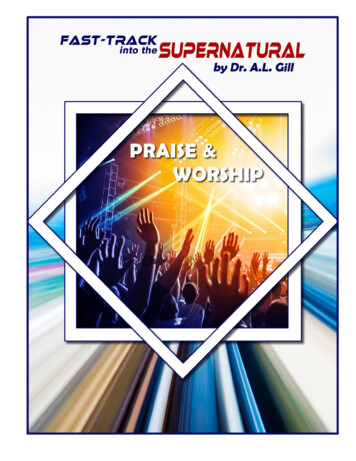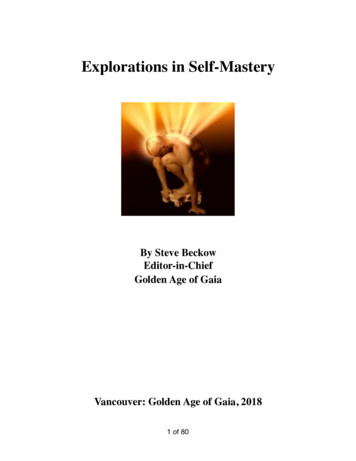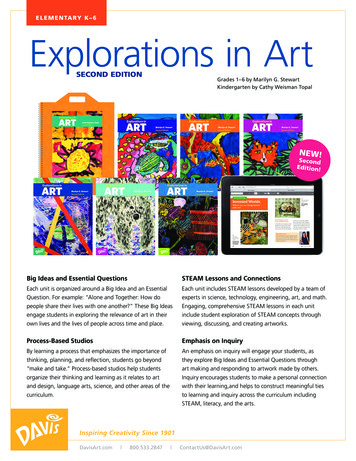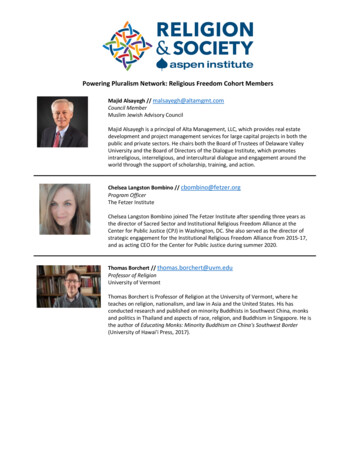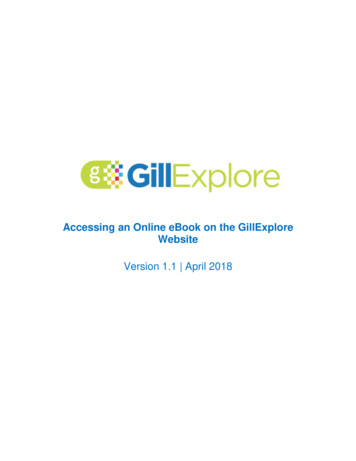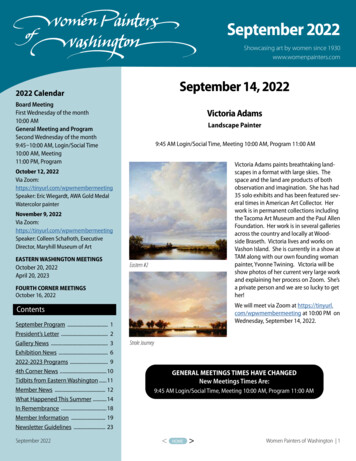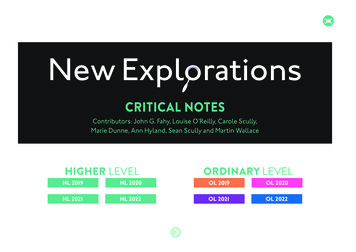
Transcription
New ExplorationsCRITICAL NOTESContributors: John G. Fahy, Louise O’Reilly, Carole Scully,Marie Dunne, Ann Hyland, Sean Scully and Martin WallaceHIGHER LEVELORDINARY LEVELHL 2019HL 2020OL 2019OL 2020HL 2021HL 2022OL 2021OL 2022
HIGHER LEVELPoets prescribed for examination in 20192019Elizabeth BishopSeamus HeaneyGerard Manley HopkinsBrendan KennellyD. H. LawrenceEiléan Ní ChuilleanáinSylvia PlathW. B. Yeats2
HIGHER LEVELPoets prescribed for examination in 20202020Eavan BolandEmily DickinsonPaul DurcanRobert FrostD. H. LawrenceEiléan Ní ChuilleanáinAdrienne RichWilliam Wordsworth3
HIGHER LEVELPoets prescribed for examination in 20212021Elizabeth BishopEavan BolandPaul DurcanRobert FrostSeamus HeaneyGerard Manley HopkinsJohn KeatsSylvia Plath4
HIGHER LEVELPoets prescribed for examination in 20222022Elizabeth BishopEmily DickinsonJohn KeatsBrendan KennellyD. H. LawrenceAdrienne RichWilliam WordsworthW. B. Yeats5
WILLIAMWORDSWORTHHL 2020OL 2020HL 2022OL 2022Notes and Explorations: Carole ScullyPOEMS PRESCRIBED FOR BOTH HL AND OL IN GREENIntroductionfrom The Prelude:The Stolen Boat [II 357–400]To My SisterSkating [II 425–463]A slumber did my spirit sealTintern AbbeyShe dwelt among the untrodden waysWordsworth’s poems in chronological orderComposed upon Westminster Bridge, September 3, 1802Developing a personal response to the poetry ofWilliam WordsworthIt is a beauteous evening, calm and freeThe Solitary ReaperQuestionsBibliography6
NEW EXPLORATIONSWILLIAM WORDSWORTHINTRODUCTIONINTRODUCTIONEarly lifeWilliam Wordsworth was born on 7 April 1770 in Cockermouth,Cumberland in the north-west of England, an area noted forits beautiful scenery. He was the second son born to JohnWordsworth and his wife Anne. Wordsworth’s family wascomfortable both financially and socially. His father was anattorney-at-law and a land steward, while his mother came froma respectable merchant background. Less than two years later, hissister Dorothy was born and the two children developed a closerelationship that was to continue into adult life. Sadly, this stablechildhood world was rocked by the death of his mother whenWordsworth was eight years old, and his father’s death five yearslater. Some critics have suggested that the loss of his parentsat such a young age had a lasting effect on Wordsworth, in thatmuch of his poetry is underpinned by a sense of searching for anabsent quality that will somehow fill a gap in his life. In one of hisearliest poems, composed when he was about sixteen years old,Wordsworth writes:Now, in this blank of things, a harmonyHome-felt, and home-created comes to healThat grief for which the senses still supplyFresh food; for only then, when memoryIs hushed, am I at rest.Two of their uncles became guardians to the five Wordsworthchildren and ensured that they were brought up in a mannersuitable to their social station. Wordsworth attended HawksheadGrammar School and, at the age of seventeen, entered St John’sCollege, Cambridge.Wordsworth’s career at Cambridge was undistinguished, but thelong holidays gave him the opportunity to indulge in a favouritepastime, walking in the countryside. The appreciation of Natureand the first-hand experiencing of the natural world becameincreasingly popular towards the end of the eighteenth century.In the summer of 1790, Wordsworth and a college friend wenton a walking holiday through France and Switzerland, ‘staff inhand, without knapsacks, each his neediments tied up in a pockethandkerchief’. Wordsworth was impressed by the majesty of theAlps and wrote a series of ‘Descriptive Sketches’ detailing thescenery:The rocks rise naked as a wall, or stretchFar o’er the water, hung with groves of beech In later life, Wordsworth came to view these pieces asrepresenting a time when he was enveloped by the visualaspect of Nature, when he revelled in seeing, with little or nounderstanding of the spiritual quality of the natural world. At thisstage, his writing was very much in tune with the poetry of thetime, where natural beauty was described in detailed word pictureswithout intellectual consideration.After receiving his BA, Wordsworth returned to France withthe intention of learning French. However, he was diverted bywilliam wordsworth index7
NEW EXPLORATIONSWILLIAM WORDSWORTHINTRODUCTIONa growing interest in the revolutionary movement that wassweeping through France, and by his love affair with AnnetteVallon, who bore him a daughter. However, under pressure fromhis friends and relations who were anxious about the politicalinstability in France, Wordsworth returned to England and was notto see his daughter until she was nine years old.Samuel Taylor ColeridgeOn his return from France, Wordsworth rather reluctantlypublished some of his work. The books were not particularlywell received and sold slowly. However, another young writer,Samuel Taylor Coleridge, did read them and was immenselyimpressed, commenting: ‘Seldom, if ever, was the emergence ofan original poetic genius above the literary horizon more evidentlyannounced.’ The pair met in 1795 and became great friends,travelling and writing together. At Coleridge’s suggestion theybegan to write a series of poems that was to become The LyricalBallads, generally recognised as marking the beginning of theRomantic Movement in English poetry. This collaboration resultedin Wordsworth producing some of his most uniquely individualpoetry, such as parts of The Prelude, the ‘Lucy’ poems and ‘TinternAbbey’. Coleridge regularly visited Wordsworth and his sisterDorothy at Grasmere, in the Lake District. Although she was atalented writer herself, Dorothy devoted most of her energiesto caring for her brother until his death in 1850. Even whenWordsworth married Mary Hutchinson in 1802, Dorothy continuedto live with the couple and was very much a part of the literarygroup that developed around Wordsworth. In 1810 the friendshipbetween Coleridge and Wordsworth ended. During one of hiswilliam wordsworth indexvisits to the Wordsworths, Coleridge’s addiction to opium led himto behave in an extremely difficult manner and Wordsworth grewtired of trying to cope with it all. When Coleridge discovered thatWordsworth had spoken dismissively of him to a friend, he wasdeeply hurt and the two men were estranged for quite a while.Finally they did patch up their relationship, but it was never thesame. Coleridge wrote, ‘A reconciliation has taken place – but thefeeling can never return.’Wordsworth’s poetic theoryIt was a sad end to what had been a wonderfully creativefriendship. Long discussions with Coleridge had led Wordsworthto formulate his theories on poetry, which he expressed in hisfamous ‘Prefaces’. He saw poetry as originating ‘from emotionrecollected in tranquillity’: that is, sensory memory is used torecreate a moment arising in ‘everyday life’, made significantby ‘powerful feelings’. By revisiting the emotionally significantmoment through sensory memory, a further quality is added tothe original experience. The moment is uniquely personal to thepoet, but because of the way in which he expresses it the momenttakes on a more general relevance to all people. For Wordsworth,the poet has ‘a greater readiness and power in expressing what hethinks and feels’. But he is, above all, ‘a man speaking to men’. Forthis reason, the poet should use ‘a selection of language reallyused by men’ in such a way that ‘ordinary things are presentedto the mind in an unusual aspect’. In this way, the poet creates anew moment that has significance not only for himself, but alsofor his reader. It encapsulates ‘truth, not individual and local, butgeneral, and operative; not standing upon external testimony,8
NEW EXPLORATIONSWILLIAM WORDSWORTHINTRODUCTIONbut carried into the heart by passion’. For Wordsworth, Natureplayed a vital role in this truth, since the poet ‘considers manand nature as essentially adapted to each other, and the mind ofman as naturally the mirror of the fairest and most interestingproperties of nature.’ Thus, ‘Poetry is the image of man and nature.’Wordsworth believed that Nature was symbolic of the essentialTruths that could give coherence to an apparently disorderedworld and, because of this, it triggers significant moments ofemotion in the poet. Poetry, that expressed these moments ofsignificance, enabled the reader to understand something of thegreat truths underlying both his or her own existence and thesociety and world in which he lived. For Wordsworth, this act ofpoetic creation helped both the poet and the reader to restoresomething that could be lost, all too easily, in everyday life:the power to escape from the physical limitations of time andplace, to grow positively and strongly in the face of an apparentlyconfused universe, to improve the social context of humanexistence, to experience joyfully the emotionally significantmoment.The later yearsWordsworth, by the poetic theory that he had formulated,came to view the poet, and therefore himself, as an individualset apart. His focus was on his own emotional reactions. InThe Prelude, composed between 1799 and 1805, he traced the‘Growth of a Poet’s Mind’, that is, his own mind, with a series ofvivid and immediate descriptions. Although Wordsworth himselfconsidered this an acceptable poetic\ stance, and many of hisdevoted readers felt that it was an approach justified by his incisivewilliam wordsworth indexobservations, an equal number of his contemporaries viewed it asindulgently self-centred and egotistical. Indeed, this divergenceof opinion regarding Wordsworth still exists today. Nevertheless,despite the mixed reactions, he continued to write in thispersonalised manner, stating that ‘Every author, as far as he is greatand at the same time original, has had the task of creating the tasteby which he is to be enjoyed.’ Yet, in truth, Wordsworth began tolose his creative way after 1808. For ten years he had written withan uncompromising vitality and an unshakeable self-belief. Whenhe completed ‘The White Doe of Rylstone’, he seemed to losetouch with the impetus that had driven his creativity. Perhaps hehad simply used up all the self-focused moments of emotionalsignificance from his memory. For whatever reason, after thistime Wordsworth’s work is never more than competent. He hadpeaked by the time he was thirty-eight and for the next fortyyears he tried, but failed, to climb again to that heady summit ofcreativity. Nowhere is this more evident than in his two versionsof The Prelude. The first version of 1805 is separated from thesecond of 1850 by some forty-five years, but by an eternity ofemotion. The older Wordsworth seems to feel embarrassed, orat the very least uneasy, in the face of the intensities of his youth.However, by this stage of his life he had seen his great worksachieve widespread recognition and approbation. As Thomas deQuincey, a contemporary of Wordsworth put it, ‘Up to 1820 thename of Wordsworth was trampled underfoot; from 1820 to 1830it was militant; from 1830 to 1835 it has been triumphant.’ In 1843Wordsworth was appointed Poet Laureate and received a statepension. He died at his home, Rydal Mount, at the age of eighty in1850. He was buried in Grasmere churchyard, in the same beautiful9
NEW EXPLORATIONSWILLIAM WORDSWORTHINTRODUCTIONnorth-west region of England where he had been born and hadlived most of his life.Wordsworth – the Romantic poetThe terms ‘Romantic’ and ‘Romanticism’ are deceptively easy touse in a literary context, probably because they have a distantbranch in everyday language. We tend to use ‘romantic’, witha lower-case ‘r’, to denote a particular aspect of being in love.It also represents a kind of idealised quality connected withfictional characters. In the case of women, the ‘romantic’ heroinecarries the connotation of intensity of repressed emotion, anapparent vulnerability concealing strength of passion; while withmen, the ‘romantic’ hero usually exhibits an irresistibly attractivedisregard for the rules of social behaviour, a sense of freedomfrom convention. In the 1980s ‘New Romantics’ appeared in theworld of popular music, representing a backlash against the overtbrutality and harshness of punk music with a less aggressive,gentler, more feminine ethos encapsulated by their white, frillyshirts and use of make-up.There is a general sense of what ‘romantic’ means, but it is a greatdeal harder to actually define ‘Romantic’, with a capital ‘R’, in aliterary context. Perhaps the most important factor to understandabout ‘Romanticism’ is that it is a term that was applied after thefact to a particular style of writing and a group of writers. It was notuntil the nineteenth century that the ‘Lake School’, comprisingWordsworth, Coleridge and Southey, and the later poets Byron,Leigh Hunt, Shelley and Keats, were grouped together under thetitle of the ‘Romantic School’, in a deliberate attempt to connectwilliam wordsworth indexthis disparate group with the ‘Romantics’ of Germany and France.At this time, the term carried a historical connotation, as ThomasArnold explained in 1862: ‘By romantic poems we mean, poemsin which heroic subjects are epically treated, after the mannerof the old romances of chivalry.’ In the context of this definition,Coleridge, Byron and the novelist Sir Walter Scott were viewed asthe great ‘Romantic’ writers. Indeed, Wordsworth was, to a largeextent, placed on the margins of the Romantic group.However, by the 1930s Wordsworth had been allocated a centralrole in ‘Romantic’ writing. Writers such as T. S. Eliot and F. R. Leavisreawakened an interest in his work. Although Wordsworth did notwrite about the historical subjects that Arnold, in the nineteenthcentury, considered prerequisite to ‘Romanticism’, he did expressmany of the features that were regarded in the twentieth centuryas characteristic of it. First, Wordsworth represented the selfconscious individualisation of the poet when he advocated thatthe poet ‘ought to travel before men occasionally as well as attheir sides’. Allied to this was his idealisation of the poet’s role toa prophet-like status: ‘the Poet, singing a song in which all humanbeings join with him, rejoices in the presence of truth as ourvisible friend and hourly companion’. In some twentieth-centurydefinitions of ‘Romanticism’, this idealised individualisation wasseen as enabling the poet to arrive at an understanding that wouldbenefit human society in general. F. R. Leavis commented thatWordsworth showed the reader ‘the significance of this poetryfor actual living’. He believed that Wordsworth’s poetry was ‘theexpression of an order and the product of an emotional and moraltraining’.10
NEW EXPLORATIONSWILLIAM WORDSWORTHINTRODUCTIONSecond, it was generally agreed that the impetus for the‘Romantic’ writer sprang from his relationship with Nature. Onceagain Wordsworth epitomised this relationship with his view thatpoetry ‘is an acknowledgement of the beauty of the universe’. Hiscombination of personal memory, imagination and observationwas seen as representing the ‘Romantic’ approach to Nature. M. H.Abrams described ‘Tintern Abbey’ as ‘the joint product of externaldata and of the mind’. Finally, Wordsworth’s poetry expressedthe intensity that is fundamental to the twentieth-centuryinterpretation of ‘Romanticism’, both in an emotional sense,when he tried to write of ‘the spontaneous overflow of powerfulfeelings’, and on a sensory level, when he stated that poetryshould ‘treat of things not as they are but as they appear; not asthey exist in themselves, but as they seem to exist to the senses’.Thus for readers in the twentieth century, Wordsworth is a perfectexample of a ‘Romantic’ poet, if there can be such a thing asa perfect example of a rather vague definition. M. H. Abramssummed up the problematic nature of the word ‘Romantic’ whenhe commented that it is ‘one of those terms historians can neitherdo with nor make do without’. Perhaps the best way to ensure thatwe treat the term with caution is to remind ourselves that couldwe return to the eighteenth century and visit Wordsworth in hishouse, set in the beautiful mountains, he would undoubtedlyreact with bemused and disconcerted puzzlement if we wereto greet him with ‘You must be Wordsworth, the great Romanticpoet’!william wordsworth index11
NEW EXPLORATIONSWILLIAM WORDSWORTHTO MY SISTERTO MY SISTERthe day in ‘idleness’, so she should leave her book inside alongwith her indoor clothes. These ideas recur in the final stanza.BackgroundAt this point, the poem changes from a simple description of atime and place to a reflection on the effects of Nature on Man. Inthis way, the moment becomes significant. Wordsworth describesthese effects in the context of his group, but the implicationis that the message applies to all men. The ordering of Timeby a calendar is portrayed as arbitrary and restrictive, whereasthe internal time that governs Nature is natural and positive.Wordsworth feels that by being outside, within Nature, Man openshimself to the Great Truths that Nature symbolises. Love, perhapsthe greatest Truth of all, fills the natural world.This poem was written and published in 1798, when Wordsworthwas twenty-eight years old. At this point he was living with hissister Dorothy and was working closely with Samuel TaylorColeridge on the Lyrical Ballads.StructureThe poem consists of ten stanzas. Each stanza contains four lineswith a rhyme scheme of abab. The final stanza largely repeats thefourth one, both for emphasis and to give a sense of unity to thepoem.A reading of the poemThe first two stanzas of the poem show Wordsworth at hisdescriptive best. Within the restraints of four-line stanzas and astrict rhyme scheme, he manages to create a vivid and evocativedescription of ‘the first mild day of March’. He appeals to the senseof sight, the sense of hearing and the sense of touch in orderto give the scene depth and realism. He uses ‘the very languageof men’, but in such a way that it is expanded in the power of itscommunication.In the third stanza he addresses his sister, attempting to persuadeher to spend the day outside. He tells her to change into her‘woodland dress’, perhaps implying that she will be much morecomfortable in this relaxed outfit rather than the more formalclothes that she wears indoors. He suggests that they will spendwilliam wordsworth indexWordsworth does not simply mean that Spring is the time ofgrowth and procreation in the natural world. Love, for him, is theinstinct to exist in a positively creative way. It is an instinct that Mancan all too easily lose by locking himself into the inside world ofdaily tasks, books and calendars. The spaciousness of the outsideworld fills and extends the very essence of Man. Then Man, in histurn, surrenders up something of his creativity to Nature. It is amutually beneficial relationship that moves ‘From earth to man,from man to earth’.Just as Wordsworth sees a clear contrast existing between theinside and outside worlds, so he also views the way Man learnsin each world as being distinctly different. In the inside world,learning is made up of ‘toiling reason’ for the intellect; but outside,learning becomes effortless and spontaneous. It is a completeexperience for the mind and the body: ‘Our minds shall drink12
NEW EXPLORATIONSWILLIAM WORDSWORTHTO MY SISTERat every pore’. Nature creates a situation where Man learns in aholistic way: that is, the learning becomes relevant to his veryspiritual essence. What is absorbed outside, close to Nature, hasa fundamental effect: ‘We’ll frame the measure of our souls’. Itworks in a positive and constructive way, not only for the individualbut for society as a whole, because it generates a willingness to be‘tuned to love’.In the final stanza, Wordsworth once more repeats his requestthat Dorothy should change her clothes and leave her book,so that they can spend the day in ‘idleness’. However, now thatwe have read the poem we, like Dorothy, fully understand justwhat Wordsworth is suggesting. We know exactly what ‘idleness’means, so we can join Wordsworth and his sister in smiling at hisgentle joke.Alternatively‘It is possible enough, we allow, that the sight of a friend’s spade,or a sparrow’s nest might really have suggested to such a minda train of powerful impressions and interesting reflections, but itis certain that to most minds such associations will always appearforced, strained and unnatural.’So wrote Francis Jeffrey, a contemporary critic of Wordsworth. Isthis a justifiable criticism of this poem and Wordsworth’s otherworks on your course? Does he take incidents that might have alimited value and expand their relevance to such an extent thatthey are in continual danger of exploding; are they the poeticequivalent of an over-inflated balloon?StyleIt is always important to remember that Wordsworth believed thatpoetry was created out of ‘emotion recollected in tranquillity’. Soalthough he places his poems in the present, and creates a senseof spontaneous immediacy, he is writing about an incident fromthe past. Wordsworth uses memory to recall this past incidentand its accompanying emotions so that he can re-experience themoment in a new context, in ‘tranquillity’, and this enables him todraw out the depth of meaning that is embodied in the incident.In this way the moment becomes more significant. Therefore, withWordsworth, spontaneity and immediacy are to be treated withcaution!william wordsworth index13
NEW EXPLORATIONSWILLIAM WORDSWORTHA SLUMBER DID MY SPIRIT SEALA SLUMBER DID MY SPIRIT SEALBackgroundSee the Background note for ‘She Dwelt among the UntroddenWays’.A reading of the poemThe opening two lines of the poem appear to communicate animage that is readily understandable – that of Wordsworth fallinginto a sleep. He depicts the condition as a pleasant one that has‘no human fears’. The first line reinforces this by its use of the ‘s’sound, giving a relaxed and sleepy quality to the words. His use ofthe past tense clearly indicates that this incident is a recollectedone. However, with lines 3 and 4, the poem begins to move awayfrom this apparent clarity. There is an underlying uneasiness aswe encounter the puzzling ‘She’. Who or what is ‘She’? Could itbe Wordsworth’s ‘spirit’ of the first line, given a kind of timelessimmortality by the protective ‘seal’ of sleep? Or does the ‘She’refer to a separate person? By linking ‘She’ with the word ‘thing’,Wordsworth further confuses the matter. Can a ‘thing’ be human?The use of ‘seemed’ further increases this uneasiness. There isthe strong implication that the ability of this ‘She’ to resist theeffects ‘of earthly years’ was, in truth, only an appearance. Isthere a haunting sense of disappointment, perhaps even distress,underpinning these words, although they are set in the past?Wordsworth deliberately leaves these questions hanging as heleads us into the second stanza.william wordsworth indexThe second stanza opens with an unsettling change of tense. Weare now in the present. However, as the past was filled with anappearance of ability, so the present is filled with real inability.‘She’ now has ‘no motion’, ‘no force’; she is unable to hear or see.The image is clearly indicating a change in condition; but in whatway and for whom? The negatives of ‘no’ and ‘neither’ suggesta ceasing of something that was present before. Furthermore,in spite of the overwhelming image of being unable to move,or hear, or see, there is a surprising lack of emotional reaction.Finally, Wordsworth describes an image that is stunningly vividyet profoundly enigmatic. He seems to suggest that although‘She’ is no longer able to actively move, ‘She’ is, nevertheless, stillparticipating in movement: ‘Rolled round’. ‘She’ has become partof the greater motion that propels our Earth through Time andSpace. Whether this final image is to be understood as positivelycomforting, or negatively disturbing, is unclear. Reference toWordsworth’s poetic philosophy and his other works supportsthe view that Nature is a force for good in his world. However,because ‘She’ is never fully defined, because ‘She’ is altered in afundamental yet unspecified way, because Wordsworth himselfappears to be suspended in a world that is both conscious andunconscious, wakeful and sleeping, this last image neither clearlyanswers nor finally resolves the questions that were posed in thefirst stanza of the poem.14
NEW EXPLORATIONSWILLIAM WORDSWORTHA SLUMBER DID MY SPIRIT SEALAlternativelyIt is significant that, here again, the female figure is viewed asin some way having the ability to connect with Nature in aninstinctive and unconscious way, an ability that Wordsworth byimplication felt that he lacked.Samuel Taylor Coleridge guessed that this poem was written as anepitaph (words composed in memory of a person who has died),after Wordsworth had a premonition of the death of his sisterDorothy.Given that the poem was published in a group dealing with thedeath of Lucy, it is tempting to view it as simply another aspectof Wordsworth’s reaction to this event. Yet we have to pose thequestion whether the poem itself supports this interpretation.Indeed, should the meaning and relevance of a poem be dictatedby its published context? Or should a poem be taken as a separateand distinct entity, with its own uniquely individual meaning?Does it matter when or where a poem is published, or what washappening in the poet’s life at the time of its creation? By linkinga poem to all these details are we simply taking the easy optionand, although we may arrive at a satisfying explanation, have wesacrificed the essential quality that made it a poem in the firstplace? Wordsworth expressed the following view on this topic:‘Our business is with their books – to understand and enjoy them.And, of poets more especially, it is true – that, if their works begood, they contain within themselves all that is necessary to theirbeing comprehended and relished ’.william wordsworth index15
NEW EXPLORATIONSWILLIAM WORDSWORTHSHE DWELT AMONG THE UNTRODDEN WAYSSHE DWELT AMONG THE UNTRODDEN WAYSBackgroundWordsworth appears to have written the group of ‘Lucy’ poemswhen he was in Germany in the winter of 1799. They were firstprinted in the Lyrical Ballads collection in 1800. This poemappeared second in a group of three, with ‘A slumber did my spiritseal’ the third of the group. The poems have an elegiac quality inthat they lament the death of someone. However, the traditionalelegy usually laments the passing of a notable person, such as agreat poet or military hero. Wordsworth seems to deliberatelyemphasise how unknown Lucy was in order to highlight the factthat her importance came from her effect on him. Similarly,there is a sense of mystery in each of these poems not usuallyfound in the traditional elegiac form. Wordsworth avoids thestandard approach of detailing facts about the deceased in orderto heighten the sense of loss. Instead, he simply suggests certainqualities while placing most of the emphasis on how he wasaffected by the death.A reading of the poemIn the first stanza Wordsworth introduces three important ideasin connection with the deceased Lucy: (a) she lived closely withNature; (b) she had a delicate, gentle quality; (c) she lived awayfrom the company of people. Lucy lived ‘among the untroddenways’, suggesting an isolated and unspoiled countryside. Thissense of unspoiled Nature is reinforced by the ‘springs of Dove’.Modern advertising still uses the idea of ‘natural spring water’ towilliam wordsworth indexrepresent purity and untouched Nature. The connecting of Lucywith a spring called ‘Dove’ signifies a gentleness about her; this iscertainly not a raging waterfall. There is the feeling that Nature inits extreme form would have been too overwhelming for Lucy. Shefound her home in a quiet and protective natural environment.Wordsworth emphasises the lack of human relationships in Lucy’sworld by using the words ‘none’ and ‘few’. Lucy did not experiencethe positive side of human interaction, where ‘love’ and ‘praise’support the individual. However, there is no real sense that shemissed this – rather it appears that she accepted her condition;perhaps there is even the feeling that she neither knew nor caredabout such things.In the second stanza Wordsworth reinforces these ideas withthe images that he uses in connection with Lucy. By using themetaphor of the violet that is ‘half hidden’, Wordsworth impliesa shy delicacy. There is the suggestion that the violet is contentto remain hidden by the stone, just as Lucy was content to remain‘among the untrodden ways’. The fact that the stone is ‘mossy’conveys a more comfortable image than if it had been simply coldrock. It also indicates a sheltered environment, one where thedelicate ‘violet’, and by implication Lucy, would be protected. Thesimile of the star is used in a similar way. Lucy is as ‘Fair as a star’in that she is undoubtedly beautiful. The star image also conveysa sense that Lucy is somehow not of this world. She is set apartnot simply by her physical isolation, but also because she is froma different physical environment. Man can observe the star fromthe earth, but he cannot come into contact with it because itis physically impossible for him to travel the vast distance that16
NEW EXPLORATIONSWILLIAM WORDSWORTHSHE DWELT AMONG THE UNTRODDEN WAYSlies between him and the star, nor can he survive in the star’senvironment of space. So Wordsworth implies that although hewas one of the few to have seen Lucy, there was, even for him,something unattainable about her. The idea that the star is the‘only one’ shining also reinforces the sense of Lucy’s isolation fromnormal human life.In the third stanza, Wordsworth repeats the idea that Lucy wasunknown in the general world of men. His use of the phrase ‘fewcould know’ suggests that to know Lucy was a privileged or specialexperience – that he was lucky to have witnessed her existenc
published some of his work. The books were not particularly well received and sold slowly. However, another young writer, Samuel Taylor Coleridge, did read them and was immensely impressed, commenting: ‘Seldom, if ever, was the emergence of an original poetic gen
